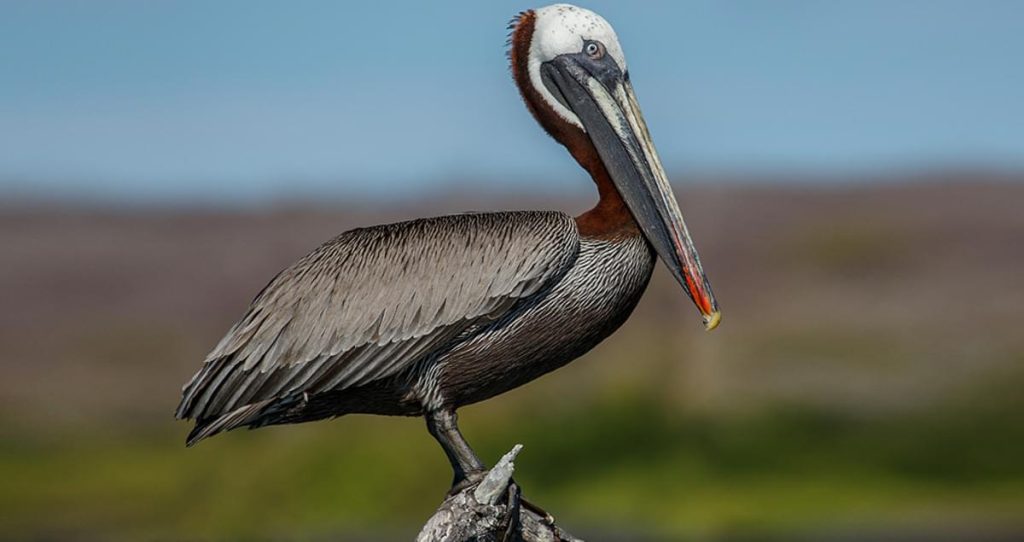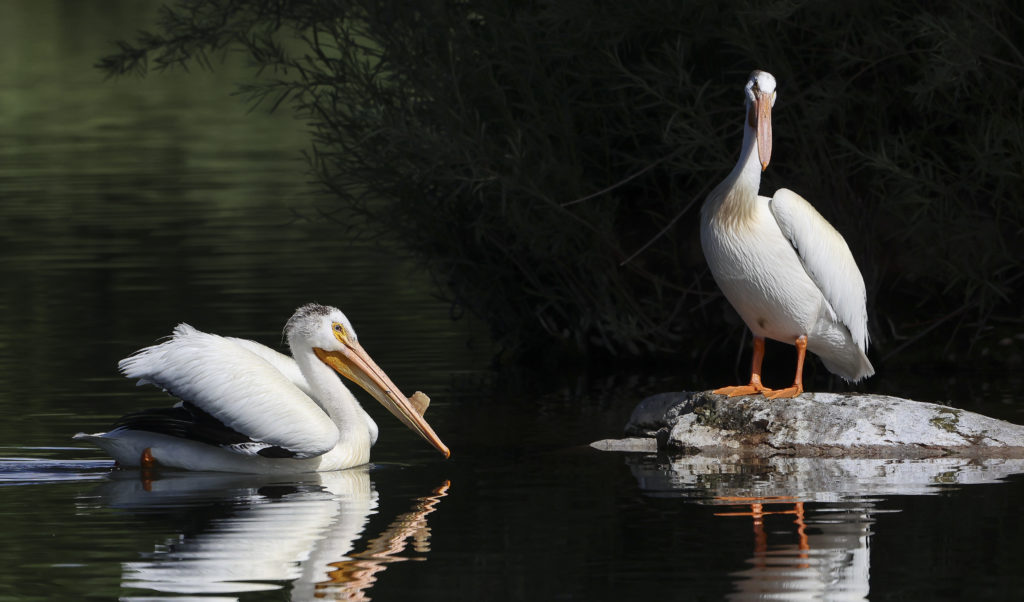In North America, Alabama serves as a haven for both species of Pelican. The American White Pelican and Brown Pelican can be sighted in this region.
Throughout the year, the Brown Pelican is a constant presence in Alabama. On the other hand, during the winter season, the American White Pelican becomes more prevalent in this state.
With their colossal bills, expandable throat pouches, and sturdy feet, Pelicans stand out as one of the largest and most recognizable avian creatures on Earth. Despite their immense size, they possess a remarkable lightness, aided by air-filled pockets in their skin and skeleton, allowing them to effortlessly float on water. Their extensive wings enable them to glide gracefully through the air.
The world harbors a total of eight pelican species, two of which reside in North America: the American White Pelican and the Brown Pelican.
During breeding seasons, Pelicans undergo vibrant transformations in their facial skin, throat, and bill colors, sometimes even growing additional structures on their bills.
Pelicans exhibit a communal breeding behavior, forming colonies of up to 50,000 birds. Depending on the species, they opt for either ground or tree nesting. After approximately 25 days of nesting, the young Pelicans assemble in “creches,” where up to 100 chicks congregate. Remarkably, the parents possess the ability to recognize and exclusively nourish their own offspring.
Despite preying on various creatures, Pelicans do not fall into the category of birds of prey, which exclusively comprises raptors. Their diet primarily consists of fish, although they occasionally indulge in crabs, frogs, snakes, mammals, birds, and insects.
Utilizing their expansive throat pouches, Pelicans adeptly catch fish, draining the water before swallowing their prey. Young Pelicans, in particular, directly feed from their parents’ throat pouches.
To assist in identifying the Pelican species observed in Alabama, this guide draws on avibase and data collected from avid bird watchers on ebird, providing authentic information about the timing of these bird sightings.
Two Pelican Species Spotted in Alabama:
Brown Pelican

Within Alabama, Brown Pelicans establish residency throughout the year, particularly in the southern region, specifically around Mobile. Bird watchers’ checklists indicate that they appear in approximately 7% of summer and winter observations.
Non-breeding adult Brown Pelicans showcase white heads and necks, adorned with pale yellow foreheads. Their lengthy bills exhibit a combination of yellow and orange hues. Grayish-brown bodies, short black legs, and webbed feet complete their appearance. Juvenile Brown Pelicans, in contrast, display brown heads, necks, backs, and wings, accompanied by bluish-gray long bills. Underneath, they sport a light brown shade.
The Brown Pelican comprises five subspecies, two of which engage in breeding within the United States. The Pacific Coast variant, P.o.californicus, and the Atlantic Coast variant, P.o.carolinensis.
Distinctive variations between Pacific and Atlantic Brown Pelicans manifest more prominently during the breeding season. Both species exhibit white heads with vivid yellow foreheads. The color of their napes transitions from white to dark brown. While Atlantic Brown Pelicans possess olive-brown throat pouches, Pacific Brown Pelicans exhibit red skin within their throat pouches.
- Pelecanus occidentalis
- Length: 48 – 50 in (122 – 127 cm)
- Weight: 131.2 oz (3718 g)
- Wingspan: 78 – 84 in (198 – 213 cm)
Brown Pelicans either breed, migrate, or establish year-round residency along the Pacific and Atlantic Coasts of North America, extending to northern South America.
These pelicans frequent environments with shallow water. They permanently reside in estuaries and coastal marine habitats. Additionally, they can be observed resting on mangrove islets, sandbars, breakwaters, and offshore rocks.
Brown Pelicans possess a unique foraging ability that distinguishes them. They expertly plunge into deep oceanic waters, capturing prey within their expansive throat pouches. Upon resurfacing, the water drains from their pouches, enabling them to immediately consume their catch.
Their diet predominantly comprises fish such as sardines and herring. When not engaged in diving, they leisurely swim, seizing prey with their bills. They may also consume crustaceans, frogs, amphibians, eggs, and other juvenile birds.
Adult Brown Pelicans tend to be silent, emitting occasional grunts. Juveniles, however, vocalize loudly to solicit food.
Nests constructed by Brown Pelicans are more commonly found on the ground rather than in trees. These concealed nests serve as protective abodes, situated on islands, among mangroves, or atop cliffs. The female Pelican builds the nest using reeds, leaves, pebbles, sticks, and soil. Subsequently, she lays two to four eggs, which both parents diligently incubate for approximately a month.
Fun Fact: Brown Pelicans incubate their eggs by utilizing their webbed feet to cover them. Unfortunately, this behavior had adverse consequences for the species in the past. Due to the pesticide DDT, the thinning of eggshells occurred, resulting in breakage caused by the weight of their parents’ feet. Extensive conservation efforts were necessary to restore the Brown Pelican population.
American White Pelican

American White Pelicans tend to be more prevalent during the winter in Alabama, although some individuals can be observed throughout the year. Observations indicate their presence in approximately 1% of summer checklists and 4% of winter checklists.
As majestic, soaring birds, American White Pelicans possess the second-largest average wingspan among all North American avian species.
Non-breeding adult American White Pelicans exhibit an entirely white plumage, with only their black flight feathers becoming visible during flight or when their wings are outstretched. They boast bluish-gray eyes and possess yellow facial skin surrounding their eyes. Pale orange bills, pouches, and feet complete their appearance. Juveniles display light gray feathers with darker brown napes.
Breeding adult American White Pelicans exhibit distinct variations in coloration compared to non-breeding adults. They develop a yellow plate on their upper bills, resembling a horn. Their bodies remain entirely white, while their eyes, bills, legs, and feet become brighter shades of orange.
American White Pelicans experience several molting changes, referred to as eclipse. During spring, a visible yellowish patch emerges on their breast and chest. In summer, their heads feature blackish feathers.
- Pelecanus erythrorhynchos
- Length: 60 – 63 in (152 – 160 cm)
- Weight: 246.4 oz (6983 g)
- Wingspan: 96 – 110 in (244 – 279 cm)
American White Pelicans breed within inland remote lakes of North America before migrating to spend the winter along the southern Pacific Coast of the United States, the Gulf of Mexico, Mexico, and Central America. During migration, they can be spotted in western and central states of the US.
Preferred habitats for American White Pelicans include shallow freshwater lakes, wetlands, and the peripheries of lakes and rivers. During the winter, they can be found in coastal bays, inlets, and estuaries, where they forage in shallow waters and rest on sandbars.
Fish comprise the primary component of the American White Pelicans’ diet. They swim near the water’s surface, capturing prey with
their large bills. These pelicans also engage in coordinated group foraging with other birds, employing strategic techniques to drive fish toward the shore, facilitating efficient feeding.
They exhibit opportunistic feeding behavior, traveling considerable distances in search of better feeding grounds. Additionally, American White Pelicans may consume crayfish, amphibians, salamanders, and are known to pilfer fish from other birds on the water’s surface.
American White Pelicans tend to be silent, emitting only occasional grunts. However, their young can be rather noisy within large colonies as they vocalize to beg for food.
Nests of American White Pelicans consist of simple, shallow depressions on the ground. Twigs, sticks, reeds, and various materials are added atop the soil to provide protection for the eggs.
Both parents actively participate in incubating the one to two eggs, which requires their attention for up to thirty-six days. Regrettably, due to siblicide, where one sibling eliminates the other, only a single chick survives in each nest.
Fun Fact: The American White Pelican possesses an elongated, colossal bill capable of holding three gallons of water. When scooping fish from the sea, the pelican tilts its bill downward, allowing water to drain while retaining the fish inside its throat sac.